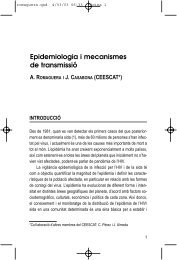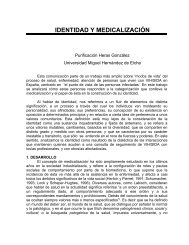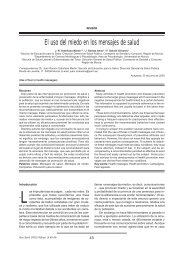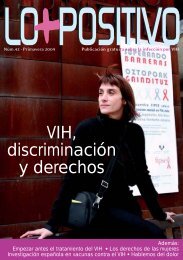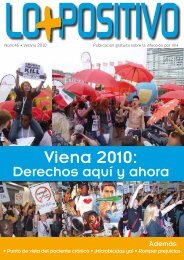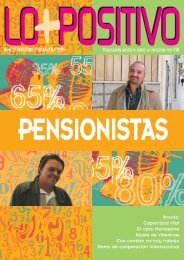Report - Sida Studi
Report - Sida Studi
Report - Sida Studi
Create successful ePaper yourself
Turn your PDF publications into a flip-book with our unique Google optimized e-Paper software.
Saturday 1 October 2005: Innovative Actions<br />
8 Plenary session 3: Innovative actions: PLWHA<br />
and access to treatment and care<br />
matization. She argued that these policy developments need<br />
to be predicated on an accurate assessment and acknowledgement<br />
of the experiences of women and to be flexible<br />
to their diversity. In relation to reaching the individual, Ms<br />
Nunes mentioned the importance of addressing women’s<br />
sense of self-efficacy, response efficacy, response costs and<br />
bolstering their assertiveness skills.<br />
She concluded her presentation with a call for action to<br />
achieve the following:<br />
• Better quality of life<br />
• More autonomy<br />
• More self-esteem<br />
• More resilience<br />
• A critical attitude<br />
• Assertive negotiation skills<br />
• Improved preventive behavioural skills<br />
She suggested that this might be accomplished through<br />
innovative action including:<br />
• Self and social development<br />
• Post-traumatic stress therapies<br />
• Emotional freedom therapies<br />
The chair thanked Ms Nunes for her presentation and<br />
drew attention to the importance of developing prevention<br />
activities which reach all people but acknowledged<br />
the particular vulnerabilities of women, especially<br />
migrant women. She introduced Mr Gonzalo Mazuela.<br />
8.22 Innovative action in targeting men who have sex with<br />
men, Mr Gonzalo Mazuela, Spain<br />
Mr Mazuela began his presentation by asking us to consider<br />
what is meant by innovation in HIV/AIDS prevention.<br />
He presented slides of several Spanish condom promotion<br />
posters, illustrating the differentiation of messages<br />
for different target groups. He pointed out that while<br />
this was somewhat innovative in terms of acknowledging<br />
different behavioural risks associated with different target<br />
groups, it lacked any deeper understanding of the factors<br />
which might militate against people being able to convert<br />
the message into action.<br />
Turning to the specific issue of targeting men who have<br />
sex with men (MSM), Mr Mazuela explained that, in his<br />
experience, it is at least in part the nature of the cultural<br />
context which affected the ability of MSM to recognise,<br />
internalise and act in accordance with these messages<br />
about safer sex. He pointed to the lowering of their selfesteem<br />
through the association of homosexuality with<br />
perversion, and suggested that campaigns simply extolling<br />
condom use and which do not take this into account<br />
are unlikely to be successful.<br />
He elaborated this point turning to the issue of reaching<br />
drug users, noting that some terms used in media campaigns<br />
and interventions do not acknowledge the meanings<br />
attached to concepts within the particular target<br />
groups (for example, the positive connotations of ‘risk’ in<br />
the context of masculinity).<br />
In Mr Mazuela’s view, these examples illustrate that currently<br />
media campaigns promoting safer sex are not sufficiently<br />
empathetic or sensitive to the experiences of the<br />
groups which they are targeting. They tend, more than<br />
anything else, to address ‘risk’, which may not always be<br />
present, but to exclude pleasure, which usually is. He<br />
argued that it might be necessary, therefore, to reconfigure<br />
publicity campaigns so that they acknowledge that<br />
MSM may use drugs in order to boost their confidence<br />
and self-esteem, and that sex itself may then be selfaffirming<br />
for them. He added that in this context giving<br />
and receiving sexual pleasure and the consequent boost<br />
to self-esteem may override any concerns with risk of<br />
exposure to HIV. He drew a comparison between risk<br />
of HIV infection and other risk activities like sports in<br />
which risk-taking is not always condemned but sometimes<br />
celebrated.<br />
In conclusion, Mr Mazuela argued that there is a need<br />
to strengthen positive behaviour rather than stigmatise<br />
negative behaviour through media campaigns and other<br />
HIV/AIDS prevention interventions. He suggested that<br />
this requires more careful and sensitive attunement with<br />
the target group and the adoption of a less patronising<br />
position on the part of HIV/AIDS prevention workers.<br />
Ms Nyambe thanked Mr Mazuela for his presentation.<br />
She noting that it served as a reminder that HIV/AIDS<br />
prevention aimed at gay men demands work to challenge<br />
homophobia. She then introduced Mr Julian Hows.<br />
8.3 Short presentations by other panel members<br />
8.31 PLWHA and access to treatment and care, Mr Julian<br />
Hows, United Kingdom<br />
Mr Hows gave a short presentation in which he argued<br />
for action to challenge inequalities in relation to access to<br />
HIV/AIDS treatment and care. He discussed the claims<br />
made by UNAIDS and WHO that in 2005, PLWHA in<br />
Western Europe had universal access to treatment and<br />
care and half of all PLWHA in Eastern Europe had access<br />
to treatment and care. Mr Hows held these claims to be<br />
misleading, since universal access was defined here as<br />
representing more the 80% of the population of HIV+<br />
persons. He commented that it was his view that those<br />
excluded for access to treatment and care would include<br />
the most vulnerable and marginal groups of migrants,<br />
19



